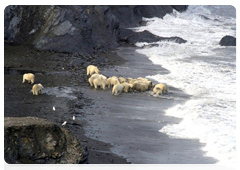MULTIMEDIA
 +
+
Polar bears do not hunt in groups. However, they are known to share food with each other. They can be seen together eating a prey shoulder to shoulder, showing great tolerance and dealing with each other without the slightest sign of aggression
 +
+
Polar bears hunt successfully on coastal areas, feeding on the carcasses of dead marine mammals such as whales that have washed up on shore
 +
+
Polar bears do not hunt in groups. However, they are known to share food with each other. They can be seen together eating a prey shoulder to shoulder, showing great tolerance and dealing with each other without the slightest sign of aggression
 +
+
Polar bears do not hunt in groups. However, they are known to share food with each other. They can be seen together eating a prey shoulder to shoulder, showing great tolerance and dealing with each other without the slightest sign of aggression
 +
+
Polar bears do not hunt in groups. However, they are known to share food with each other. They can be seen together eating a prey shoulder to shoulder, showing great tolerance and dealing with each other without the slightest sign of aggression
 +
+
A polar bear swims in the open sea to escape danger. If polar bears cannot find ice blocks nearby, they may swim long distances and run the risk of exhaustion, which decreases their chances of survival.










 ABOUT THE PROGRAMME
ABOUT THE PROGRAMME
 POLAR BEAR RESEARCH: A HISTORY
POLAR BEAR RESEARCH: A HISTORY
 POLAR BEAR: LIFE, BEHAVIOUR AND MORE
POLAR BEAR: LIFE, BEHAVIOUR AND MORE
 VLADIMIR PUTIN'S VISIT
VLADIMIR PUTIN'S VISIT
 NEWS
NEWS
 MULTIMEDIA
MULTIMEDIA